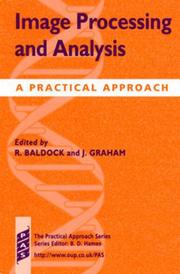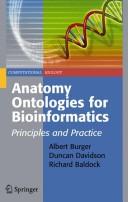| Listing 1 - 6 of 6 |
Sort by
|

ISBN: 1280375604 9786610375608 0585483590 9780585483597 1280756403 9781280756405 9781280375606 0199637016 9780199637010 0199637008 9780199637003 9780191565816 0191565814 Year: 2000 Publisher: Oxford Oxford University Press
Abstract | Keywords | Export | Availability | Bookmark
 Loading...
Loading...Choose an application
- Reference Manager
- EndNote
- RefWorks (Direct export to RefWorks)
A wide range of books on image processing and analysis provide comprehensive descriptions of mathematics and algorithms for image processing practitioners, or introductory material for engineering students. This volume is different in addressing the topic from the point of view of the "user". Standard algorithms, procedures and rules of thumb are explained in the context of successful application to biological or medical images. Early chapters cover the basic topics of image acquisition, processing, analysis and pattern recognition. Much of the explanation is in the form of protocols, which should equip the user in the biological or earth sciences with the background for informed use of image processing software, and sufficient knowledge to write their own programmes if they feel moved to do so. More advanced techniques in the use of explicit models and analysis of 3D images are covered in later chapters, also with reference to specific applications. The coverage of these is not exhaustive, but may inspire the reader to consider applying image analysis to problems beyond those tackled by commercial packages.
Image processing. --- Pictorial data processing --- Picture processing --- Processing, Image --- Imaging systems --- Optical data processing --- Imaging systems in medicine --- Image analysis --- Image processing --- Image Processing, Computer-Assisted --- Microscopy --- Data processing --- Digital techniques --- methods --- Image analysis - Data processing --- Image processing - Digital techniques --- Image Processing, Computer-Assisted - methods --- Microscopy - methods

ISBN: 1281142786 9786611142780 1846288851 1846288843 1849966664 Year: 2008 Publisher: London : Springer,
Abstract | Keywords | Export | Availability | Bookmark
 Loading...
Loading...Choose an application
- Reference Manager
- EndNote
- RefWorks (Direct export to RefWorks)
Bioinformatics as a discipline has come of age, and there are now numerous databases and tools that are widely used by researchers in the biomedical field. However, successful development of future bioinformatics applications will depend on an appropriately formalised representation of domain knowledge. This book provides a timely and first-of-its-kind collection of contributed chapters on anatomy ontologies. It is interdisciplinary in its approach, bringing together relevant expertise from computing and biomedical studies, and covering both theoretical and applied aspects, with an emphasis on newer work relevant to the emerging Semantic Web. Topics and Features: • Provides a comprehensive discussion of the foundations of anatomical ontologies and the state of the art in existing computational tools and applications • Considers a number of fundamental modelling principles • Includes chapters about research on algorithms to systematically align anatomy ontologies and to mine data in the literature, using anatomy terms • Explains recent efforts to develop a common anatomy reference ontology • Discusses anatomy in the context of spatio-temporal biomedical atlases • Describes systems and tools for linking anatomy ontologies with each other and with other on-line resources, such as the biomedical literature • Highlights the challenges of dealing with anatomy-based information on the Semantic Web Although primarily written for readers who will be involved in developing the next generation of IT applications in the areas of life sciences, biomedical sciences and health care, this unique volume will be of interest to anyone who will further develop anatomy ontologies, who will use them, and who will be involved in the actual development of relevant (semantic) web applications.
Bioinformatics. --- Computational biology. --- Ontologies (Information retrieval) --- Bio-informatics --- Biological informatics --- Biology --- Information science --- Computational biology --- Systems biology --- Data processing --- Data structures (Computer science) --- Bioinformatics --- Biomedical engineering. --- Computer science. --- Database management. --- Biomedical Engineering and Bioengineering. --- Computational Biology/Bioinformatics. --- Information Systems Applications (incl. Internet). --- Models and Principles. --- Database Management. --- Data base management --- Data services (Database management) --- Database management services --- DBMS (Computer science) --- Generalized data management systems --- Services, Database management --- Systems, Database management --- Systems, Generalized database management --- Electronic data processing --- Informatics --- Science --- Clinical engineering --- Medical engineering --- Bioengineering --- Biophysics --- Engineering --- Medicine --- Application software. --- Computers. --- Automatic computers --- Automatic data processors --- Computer hardware --- Computing machines (Computers) --- Electronic brains --- Electronic calculating-machines --- Electronic computers --- Hardware, Computer --- Computer systems --- Cybernetics --- Machine theory --- Calculators --- Cyberspace --- Application computer programs --- Application computer software --- Applications software --- Apps (Computer software) --- Computer software
Multi
ISBN: 9781846288852 Year: 2008 Publisher: London Albert Burger, Duncan Davidson, Richard Baldock
Abstract | Keywords | Export | Availability | Bookmark
 Loading...
Loading...Choose an application
- Reference Manager
- EndNote
- RefWorks (Direct export to RefWorks)
Metaphysics --- Biomathematics. Biometry. Biostatistics --- Molecular biology --- Computer science --- Programming --- Information systems --- Computer. Automation --- ICT (informatie- en communicatietechnieken) --- IR (information retrieval) --- ontologie --- bio-informatica --- informatica --- informatiesystemen --- biometrie --- database management --- moleculaire biologie
Book
ISBN: 0128009136 0128000430 9780128009130 9780128000434 Year: 2015 Publisher: Saint Louis : Elsevier Science,
Abstract | Keywords | Export | Availability | Bookmark
 Loading...
Loading...Choose an application
- Reference Manager
- EndNote
- RefWorks (Direct export to RefWorks)
Kaufman's Atlas of Mouse Development: With Coronal Sections continues the stellar reputation of the original Atlas by providing updated, in-depth anatomical content and morphological views of organ systems.The publication offers written descriptions of the developmental origins of the organ systems alongside high-resolution images for needed visualization of developmental processes. Matt Kaufman himself has annotated the coronal images in the same clear, meticulous style of the original Atlas. Kaufman's Atlas of Mouse Development: With Coronal Sections follows the original Atlas as a continuation of the standard in the field for developmental biologists and researchers across biological and biomedical sciences studying mouse development. Provides high-resolution images for best visualization of key developmental processes and structures; Offers in-depth anatomy and morphological views of organ systems; Written descriptions convey developmental origins of the organ systems.
Mice --- House mice --- House mouse --- Mouse --- Mus musculus --- Rodents --- Embryology. --- Development. --- Physiology.
Book
ISBN: 9781846288852 Year: 2008 Publisher: London Springer London
Abstract | Keywords | Export | Availability | Bookmark
 Loading...
Loading...Choose an application
- Reference Manager
- EndNote
- RefWorks (Direct export to RefWorks)
Bioinformatics as a discipline has come of age, and there are now numerous databases and tools that are widely used by researchers in the biomedical field. However, successful development of future bioinformatics applications will depend on an appropriately formalised representation of domain knowledge. This book provides a timely and first-of-its-kind collection of contributed chapters on anatomy ontologies. It is interdisciplinary in its approach, bringing together relevant expertise from computing and biomedical studies, and covering both theoretical and applied aspects, with an emphasis on newer work relevant to the emerging Semantic Web. Topics and Features: ¢ Provides a comprehensive discussion of the foundations of anatomical ontologies and the state of the art in existing computational tools and applications ¢ Considers a number of fundamental modelling principles ¢ Includes chapters about research on algorithms to systematically align anatomy ontologies and to mine data in the literature, using anatomy terms ¢ Explains recent efforts to develop a common anatomy reference ontology ¢ Discusses anatomy in the context of spatio-temporal biomedical atlases ¢ Describes systems and tools for linking anatomy ontologies with each other and with other on-line resources, such as the biomedical literature ¢ Highlights the challenges of dealing with anatomy-based information on the Semantic Web Although primarily written for readers who will be involved in developing the next generation of IT applications in the areas of life sciences, biomedical sciences and health care, this unique volume will be of interest to anyone who will further develop anatomy ontologies, who will use them, and who will be involved in the actual development of relevant (semantic) web applications.
Metaphysics --- Biomathematics. Biometry. Biostatistics --- Molecular biology --- Computer science --- Programming --- Information systems --- Computer. Automation --- ICT (informatie- en communicatietechnieken) --- IR (information retrieval) --- ontologie --- bio-informatica --- informatica --- informatiesystemen --- biometrie --- database management --- moleculaire biologie
Digital
ISBN: 9780128009130 0128009136 Year: 2015 Publisher: Amsterdam Elsevier
Abstract | Keywords | Export | Availability | Bookmark
 Loading...
Loading...Choose an application
- Reference Manager
- EndNote
- RefWorks (Direct export to RefWorks)
| Listing 1 - 6 of 6 |
Sort by
|

 Search
Search Feedback
Feedback About UniCat
About UniCat  Help
Help News
News